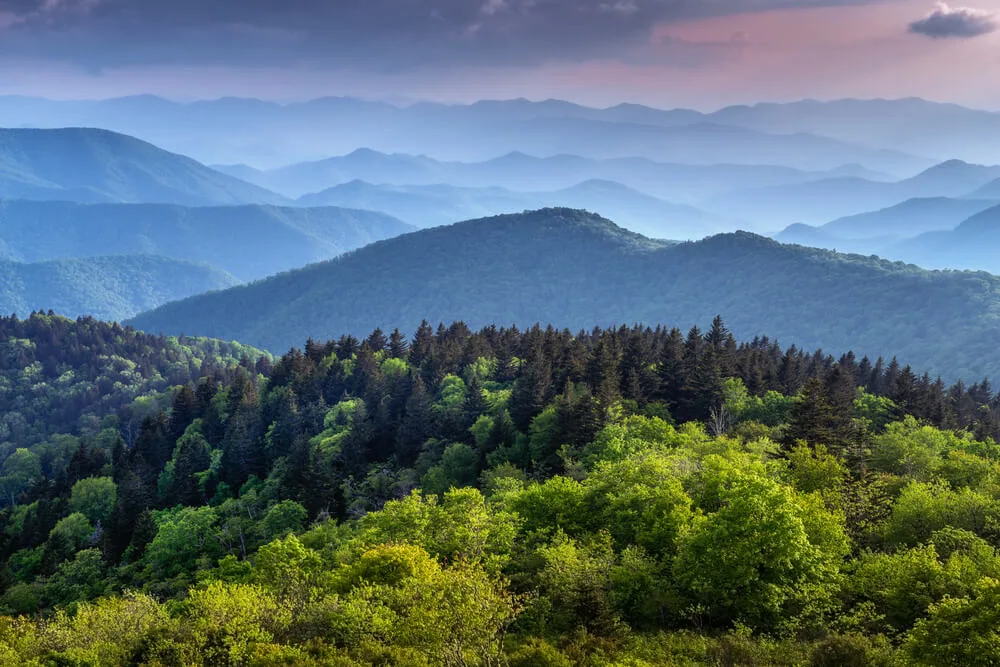
The Great Smokey Mountains of North Carolina. (Image via Shutterstock)
A tour of the state’s choice national parks and sites, from the most beautiful mountain passes to the Atlantic’s gorgeous lookouts.
Last week was National Park Week, but there’s never a bad time to enjoy the outdoors in North Carolina. So while there’s no shortage of state parks worthy of acclaim, here’s a look at some of the 12 parks, sites and historical landmarks in North Carolina run by the National Parks Service.
Blue Ridge Parkway
Every conversation should start with the Blue Ridge Parkway, the prettiest stretch on Earth according to every survey conducted in this reporter’s household eight minutes ago.
The Blue Ridge runs 469 miles between two other national parks, Shenandoah National Park in Virginia and another national park in our state, Great Smoky Mountains National Park. Some 250 of those miles are in North Carolina.
There are lots of scenic overlooks and places to stop and stare out at the otherworldly blue haze that gives the mountains their name. You may also see bears, so there’s that.
The Waterrock Knob visitor’s center is open every day of the week from 10 a.m. to 4 p.m., and you can check here for road closures and any weather-related alerts.
Cape Hatteras National Seashore
Camp on the beach, fish off the shore, drive an ATV on the sand, maybe check out some sea turtles, Cape Hatteras and its lovely lighthouse are well worth the trip. The protected stretch is on the Outer Banks and can be accessed by bridge or ferry.
And in the winter, you can see seals. OK, I’m going to stop writing about it, because otherwise I’m just going to go there now, and I can’t do that because I have to write about the next park.
Cape Lookout
Six hours south of Cape Hatteras is Cape Lookout, 56 miles of undeveloped barrier island where you have no choice but take the ferry. Lookout has all the same beach activities as Hatteras, but it also has wild horses.
And it is the first spot in the National Park Service’s Atlantic Coast properties to be designated an International Dark Sky Park. This is a fancy way of saying the night skies are so dark and exceptional here, that on a cloudless night you can see probably all the stars in the universe.
The Appalachian and Other Trails
Much of North Carolina’s national park presence emphasizes the national – like trails that stretch thousands of miles and dozens of states.
The Appalachian Trail, of course, is the jewel of any hiker’s crown, moving across wild mountains, fields and waterways from Georgia to Maine. The trail runs through North Carolina for a few feet short of 97 miles, but you can walk another 200 miles along the border with Tennessee with epic views of the same blue mountains mentioned above. Hiking the trail is top-notch bucket list material, but go prepared and make sure you know all the entrance and exit points along the way.
The AT is not the only trail NC has to offer.
The Overmountain Victory National Historic Trail winds through Virginia, Tennessee, and both Carolinas and traces a trail used by militia during the American Revolution. You can also walk the North Carolina portion of the Trail of Tears, where thousands of Cherokee were driven violently from their homes by American troops and forced to walk West across several states. At least 4,000 people died on the trail.
Kitty Hawk, the birthplace of flight
The park service runs the spot where the Wright Brothers left the ground. A few miles south of Kitty Hawk, this historical site has preserved even the sand dune Orville and Wilbur leapt from, and the location they stayed in as they were troubleshooting any setbacks.
There’s a museum, monuments and a reconstructed camp where the Wrights worked.
The Others
- The home in Flat Rock of Carl Sandburg, the poet, journalist, children’s author, social activist and Pulitzer Prize winning biographer of Abraham Lincoln.
- Fort Raleigh, Roanoke Island. The site of the first English colony in the “New World.” The museum and fort “preserves the cultural heritage of the Native Americans, European Americans and African Americans who have lived on Roanoke Island.”
- Guilford Courthouse in Greensboro, and Moores Creek in Currie, sites of key battles in the American Revolution. If re-enactments are your thing, this is the place for you.
Politics

Op-ed: Michele Morrow poses a huge threat to NC public schools
Students with disabilities would particularly suffer if Michele Morrow were to become the state Superintendent of Public Instruction, Susan Book...

Biden makes 4 million more workers eligible for overtime pay
The Biden administration announced a new rule Tuesday to expand overtime pay for around 4 million lower-paid salaried employees nationwide. The...
Local News

VIDEO: It’s Time America Caught Up with the Rest of The World on Paid Leave
View this post on Instagram A post shared by Cardinal & Pine (@cardinalandpine) “In the United States of America, no one—no...

VIDEO: Senate Republicans Block Bill to Extend Child Tax Credit
View this post on Instagram A post shared by Cardinal & Pine (@cardinalandpine) Monday was tax day, and Senate Republicans are...





